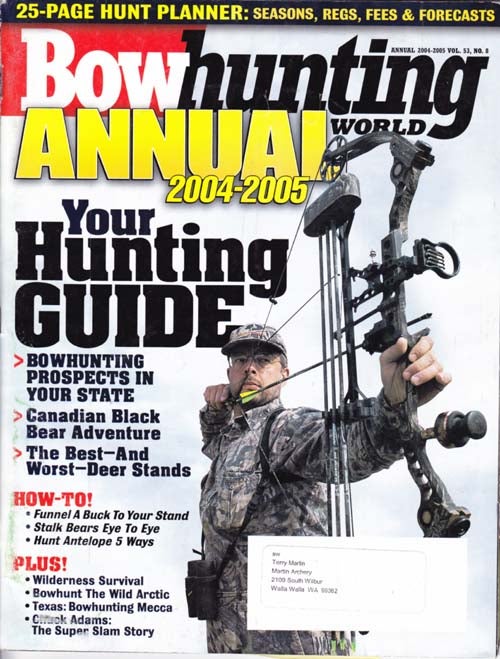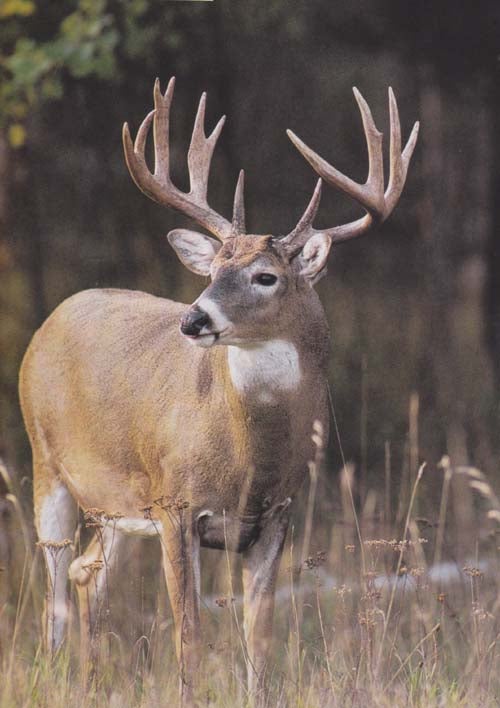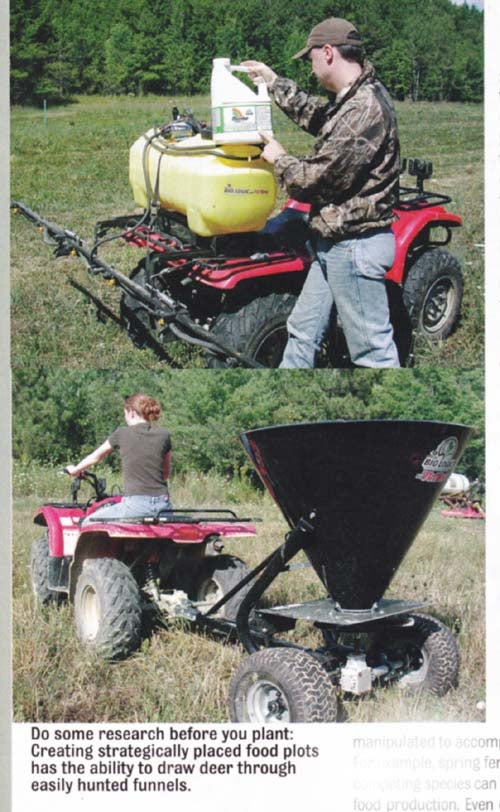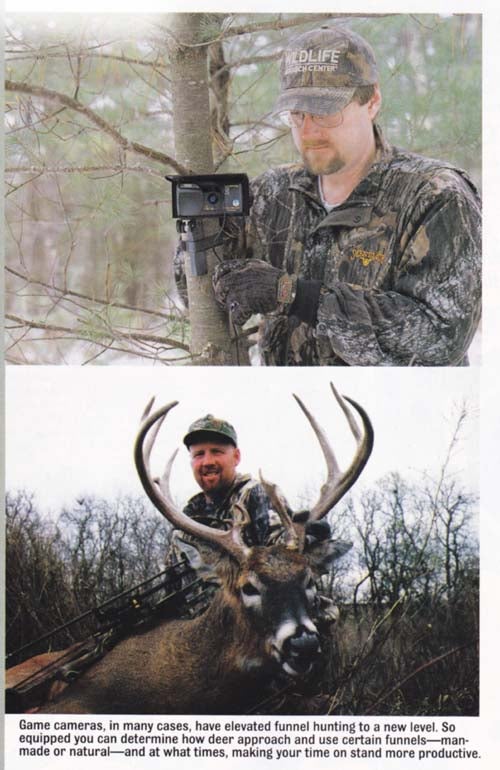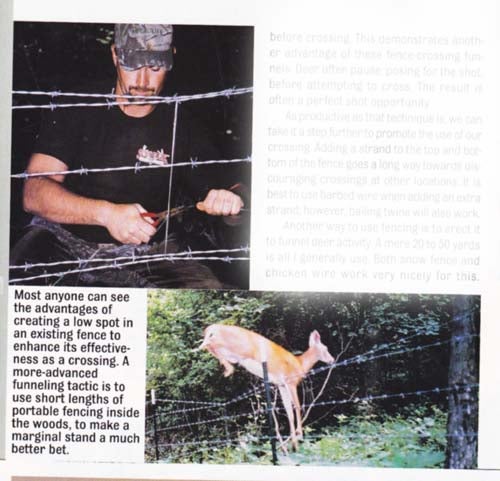Funnels in Food Plots for Deer
Funnels in Food Plots for Deer
from archery talk.com
Funneling Deer – By Steve Bartylla
It was one of the most frustrating experiences of my young bowhunting life but it was also one of the most important. As soon as school would let out, I’d grab my stuff and, brimming with anticipation, head for the stand on the alfalfa field. Yet, as darkness fell, I’d leave feeling dejected once again.
It wasn’t that I didn’t see deer. I saw plenty when walking across the field
after dark.The problem was that they were playing “musical trails.” No matter which trail I’d set up on the deer would use another. After a week of this, the breakthrough I needed finally came to me.
Truth be told, it was my trapping that led me to it. I was constructing a trail set for mink. To funnel mink movement down the main travel way, I had blocked several minor trails. As I set the trap, it occurred to me: Why couldn’t I apply the same technique to deer movement? From that moment on, I began to apply many of the trapping principles that focus animal travels to bowhunting.
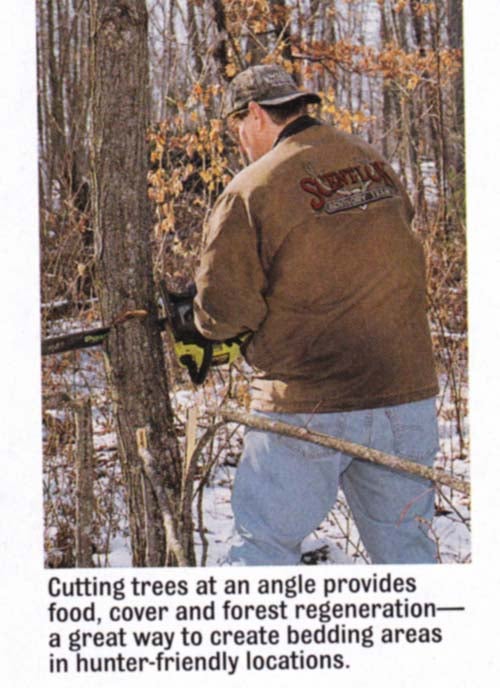
BLOCKING TRAILS
initially, it was blocking deer trails. The alfalfa field boasted five heavily used deer trails. With the landowner’s permission, I headed out with a saw and began my task The first step was choosing the trails I wanted to hunt. Because of the level of use and flexibility for wind directions, I selected the two that exited the woods on opposite inside corners. Next, I blocked the remaining trails
along the field. To accomplish that, I piled brush and limbs at the entrances. Of course, deer still could go around, but it encouraged them to use mine.
To further encourage the use of my trails, I raked the grass and debris along the first 20 yards from the point the trail entered the woods after completion, it gave the illusion that they were the field’s only primary entrance and exit routes. And, as important, they appeared as the easiest and most popular routes.
Finally, I followed the chosen trails into the woods. Where lesser-used trails splintered off toward the field, I blocked them as well. Unlike the trails entering the field, I only used enough branches to make it inconvenient to cross Because the splinter trails ran to the same field, it didn’t take as much encouragement to get deer to continue to follow the main trail.
Although these alterations may seem minor, they did make a positive difference Deer are lazy by nature. When everything else is equal, they will take the path of least resistance to where they want to go. After giving the farm a week off, sightings on the corner trail were noticeably up. On my third sit, even that young kid was able to arrow a deer. The best part of this technique is that it can be used in any situation where trails break off before hitting your stand. Furthermore, the further ahead of season this is done, and the more the blockades that are maintained, the better the results.
SETTING THE TABLE
ln later years, I began creating food plots to help funnel deer activity. Outside of the rut, most deer movement consists of traveling between bedding and feeding. Therefore, introducing a prime food source can lead deer past more advantageous stand locations.
Donnie Mc0lellan runs a very successful guide service in Grant City, Missouri Bucks
& Beards Outfitters consistently sends high percentage of their bowhunters home with trophy whitetails. One of the key reasons for this is the food plot strategy they employ.
“Finding big deer has never been a problem for me,” states Donnie. “They are here.’
It is getting my hunters into stands without tipping any deer that takes work. To avoid that, I spend countless hours walking ditches. They are one of the best ways to get in and out. In areas that don’t have good routes, I put in food plots so they draw deer through areas I can get my hunters into. I put a lot of work into it, it is worth it, though. A lot more hunters go home happy ”
To get the most from a new food plot, several factors should be considered. Because they can alter deer travels, the plots should be positioned to provide the most productive hunting. To do so, identifying bedding areas is key The plot should be located so stands can be positioned between bedding and feeding. Positioning the plot so a funnel lies between it and bedding is also advantageous. Also, undetectable routes to and from the stand should be available.
Donnie agrees with these food plot placement strategies wholeheartedly. “It all keys off of the bedding areas,” he says “I’m often shocked at how many people slap food plots out without first analyzing how they will affect deer movement and how they can place them to their own advantage. If I’m going, to go through the work to put one in, my plantings are going to be positioned so they funnel deer through areas that will do my hunters the most good !”
Additional steps can be taken to make them even better. Locating plots where deer feel safe leads to better hunting. Openings within the woods, remote corners of fields and areas bordered by thick cover all help provide the illusion of safety. If plots are positioned between 100 and 500 yards of the bedding areas, that also increases the likelihood of catching daylight movement.
Although plantings are more common, natural food sources can be manipulated to accomplish the same effect.
For example, spring fertilizing and removing competing species can increase a mast tree’s food production. Even overgrown meadows can be made more desirable through applying a lawn fertilizer and cutting them as a farmer would a hayfield. Taking these steps helps keep the grasses and weeds more digestible and nutritious, which will draw more deer. Like creating a new food plot, hunters can enhance existing food sources on locations that help funnel deer past potential stand sites.
MAKING THE BED
As stated previously, most non-rut deer travels are between bedding and feeding. Just as we can affect feeding locations with food plots and more desirable native forages, surprisingly we can also have an affect on bedding locations. Creating a bedding area can be created with a chain saw. First, select an are of woods and proceed to cut the trees within. When making the cut, begin it about three feet from the ground and cut down at a 45- degree angle, stopping about three-fourths of the way through. Now, the tree can be pushed over or left for the wind to do it.
One of the goals is to allow the branches to maintain a connection to the root system. Using this technique allows certain species such as maples and oaks, to bend without completely breaking. With the connection, the tree will to continue to grow, albeit at a much slower pace. To increase chances of survival, the cutting should be done in the winter , well before leaf-out. Keep in mind that some trees, such as poplar, birch and most pines, will snap every time, but their tops still provide food bedding cover.
This technique immediately creates a thick tangle of cover, as well as a bounty of food. The forest floor receives increased sunlight, which promotes the growth Of new greenery and
saplings. Along with that, the trees that retain the root connection provide Leafy growth for browse and buds for winter months.
To make these locations better still, we need to understand what deer seek for bed ding. Although there are exceptions, you will find that most bedding sites offer a combination of:
At least two escape routes.
Either thick cover or good visibility
Conditions allowing them to use their
sense of smell to cover their back.
These cutting technique provide the cover deer seek. Putting these efforts into locations that meet the other criteria on our list almost guarantees that deer will use them for bedding.
For example, let’s say we have a food plot along a creek bottom, flanked by ridges on each side. Applying our cutting technique the ridge side, just below the crest, would give them everything they desired. Not only do they have the thick cover, the slope also provides visibility.
By creating a bedding area on the sides of both ridges, deer would be able to choose which allowed the wind current to best cover them from the backside of the ridge. If they sensed danger, they could drop down, cut over, or dash along the ridge in either direction.
Because Nature rarely provides all of this, deer will pack into our constructed bedding sites.
Creating Trails
As in every technique discussed up to this point, knowing how the resident deer use the area is very beneficial. However, in creating trails, knowing whitetail travel patterns is essential. In order for this method to work best, you must know where the bedding and feeding areas are. Before we discuss how to create such trails, we should discuss what deer look for in selecting a travel route:
* Cover: Deer feel safest when traveling
in heavy cover.
* Gentle corners: Because they like to
see the path ahead of them, deer don’t like
taking 90 degree turns on their trails. Gently
sweeping corners allow the whitetail to see
the path before them and anticipate the dangers
that may lie ahead
* Ease of travel: Deer are lazy creatures by nature and,
all else being equal, will take the easiest route between
two points.
* Quickest route: The quickest route
between two points is a straight line. Deer
will usually select the straightest route that
provides cover, gentle corners, easiest travel
and a favorable wind direction.
With these factors in mind, we can now begin connecting food sources and bedding
areas By cleaning 5 foot-wide trails through the thickest cover between bedding and
feeding areas, we create trails that offer ease of travel, the feeling of safety and a
corridor that will be used heavily by deer. In areas that receive significant snowfalls, pulling a weighted sled along the.- trails can achieve outstanding results. In the winter months, two of the Northern whitetail’s top priorities are conserving energy and acquiring nutrition. During this difficult season, a whitetail’s life depends heavily on the amount of energy expended compared to nutrition taken in.
Creating trails through the snow that lead to the food sources creates an irresistible draw to deer enduring these conditions. So much so that once a trail is established, the heavy traffic from the deer will keep it open all winter long Because of this, the greater the snow depth, the more concentrated the deer activity becomes. Although it may seem like a lot of effort to create these trails, they are worth the effort.
FENCING
Yet another method of funneling deer is altering fences. Deer often travel significant distances to cross at the easiest point in a fence. For hunters, this is an advantage.
My first attempt at creating a fence crossing occurred many years ago on my uncle’s dairy farm I had spent a summer’s day walking a barbed wire fence line that cut through the middle of his woods About every 100 yards, I would intercept a trail that crossed the fence The problem was that no trail seemed better than any other.
Luckily, I took care of this with a little work. After selecting the fence crossing that was best for hunting, I invested a day in discouraging deer to use any other. To do that I clogged the other spots where deer crawled under and fixed up the places where the top wire strand was broken or drooped.
Finally, I made the crossing by my stand even better Wrapping a strand of wire around the fence and cinching it tight created both a low spot over which deer could jump and an easier path to crawl under.
Shoveling out some dirt underneath the fence was the icing on the cake. With that, I had the best fence crossing point. Opening day of bow season found me perched in the tree that overlooked my new fence crossing. Because of the deer sign I saw during the times I inspected and maintained my fence blockades, I was brimming with confidence So much so, that I passed
shots on the first four deer that came through That may not sound like much, but in those days shot opportunities were rare and they were the first deer I had ever taken a pass on. By the fifth, a large doe, I couldn’t resist any longer and shot as she paused before crossing. This demonstrates another advantage of these fence crossing funnels: Deer often pause, posing for the shot, before attempting to cross The result is often a perfect shot opportunity.
As productive as that technique is, we can take it a step further to promote the use of our crossing. Adding a strand to the top and bottom of the fence goes a long way towards discouraging crossings at other locations. It is best to use barbed wire when adding an extra
strand; however, bailing twine will also work.
Another way to use fencing is to erect it to funnel deer activity. A mere 20 to 50 yards is all I generally use. Both snow fence and chicken wire work very nicely for this.
Although I use this technique very sparsely, it can be extremely effective.
For example, I have a stand that is 75 yards south of a river The most commonly used trails are within 30 yards to the south of the stand. However, every now and the- . buck skirts the river without offering me a shot opportunity. Still, if I relocated closer to the river, I would miss more opportunities.
Then, one day it hit me. Just make it so that the deer couldn’t skirt me along the riverbank. Although I could have piled brush, placing 50 yards of chicken wire from the river toward my stand was much easier. Doing so has resulted in harvesting several three-year-old bucks that would have otherwise escaped unscathed.
The techniques discussed here all are proven for focusing deer movement When combined in a thorough plan, they provide a hunter the ability to dictate movement patterns to deer. Obviously, this greatly benefits those who want to make their lands produce the best possible hunting. However, without exception, the landowners permission must be sought before taking any of these steps. To not do so is simply wrong.
Archived by
all rights reserved


